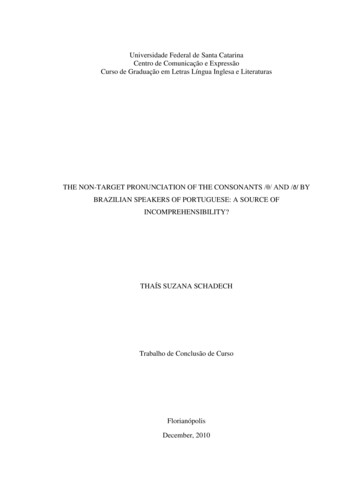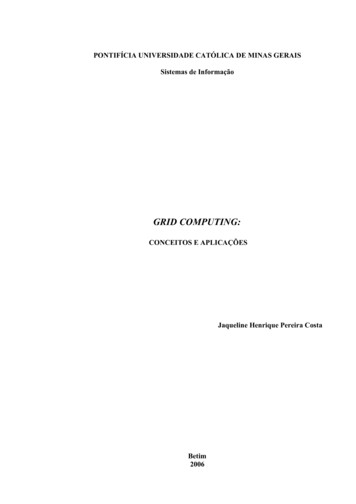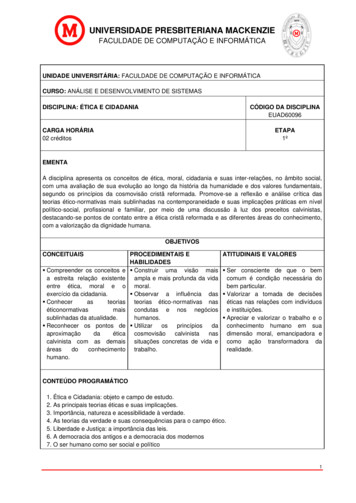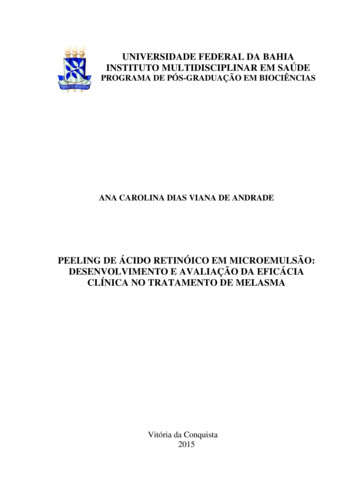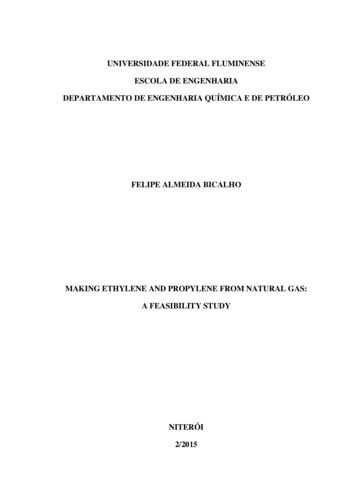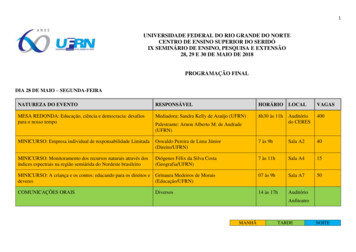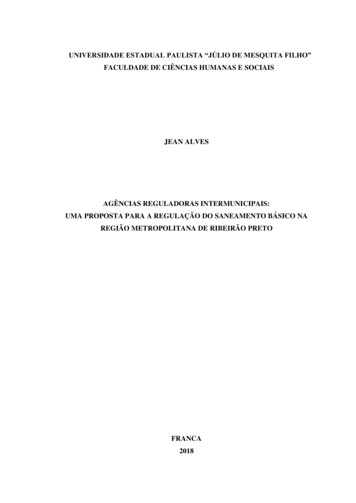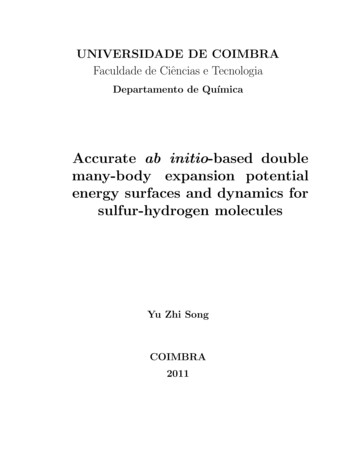
Transcription
UNIVERSIDADE DE COIMBRAFaculdade de Ciências e TecnologiaDepartamento de Quı́micaAccurate ab initio-based doublemany-body expansion potentialenergy surfaces and dynamics forsulfur-hydrogen moleculesYu Zhi SongCOIMBRA2011
UNIVERSIDADE DE COIMBRAFaculdade de Ciências e TecnologiaDepartamento de Quı́micaAccurate ab initio-based doublemany-body expansion potentialenergy surfaces and dynamics forsulfur-hydrogen moleculesDissertation presented for fulfillmentof the requirements for the degree of“Doutor em Ciências, especialidade emQuı́mica Teórica”Yu Zhi SongCOIMBRA2011
Dedicated to my family
AcknowledgmentsFirst and foremost, I would like to express my sincere thanks to my supervisor,Professor António J. C. Varandas, for his inspirational instructions, patient guidance and invaluable encouragement throughout my PhD study at the Departmentof Chemistry, University of Coimbra, Portugal. I greatly admire and appreciatehis comprehensive knowledge of Theoretical Chemistry and perseverance attitudetoward scientific research. His effort, knowledge and attitude lead me step by stepto advance in my study, and finally make this dissertation possible.Besides, I would like to thank all the members of the Theoretical and Computational Chemistry (T&CC) Group. They have created a friendly and warmatmosphere. Especially, I acknowledge Dr. Sérgio P. J. Rodrigues, Dr. PedroJ. S. B. Caridade and Dr. Luı́s A. Poveda for their instructions, discussionsand comments. Much thanks should also be given to all the other members inour group: Yongqing Li, Vinı́cius C. Mota, Luı́s P. Viegas, Breno R. L. Galvão,Maikel B. Furones, Jing Li, Biplab Sarkar, Angel C. G. Fontes, Alexander Alijah,and Flávia Rolim.I deeply express my thanks to my MSc supervisor, Professor Chuankui Wang,for his supervision and guidance during my MSc study at Shandong NormalUniversity. I take this opportunity to thank Professor Qingtian Meng and ShengluLin. I managed to join the T&CC group with their recommendation. I am alsograteful to Professor Keli Han for his help during my study in Dalian.I wish to thank the financial support from Fundação para a Ciência e a Tecnologia, Portugal, with the reference SFRH/BD/28069/2006.Finally, in particular, I would like to thank my parents, my wife and mydaughter for their unlimited love, understanding, encouragement and countlesssupport all these years.
ContentsAcknowledgmentsvForeword1BibliographyI. . . . . . . . . . . . . . . . . . . . . . . . . . . . . . . .Theoretical framework1 Concept of potential energy surface3791.1 Adiabatic representation . . . . . . . . . . . . . . . . . . . . . . .91.2 Born-Oppenheimer approximation . . . . . . . . . . . . . . . . . .121.3 Crossing of adiabatic potentials . . . . . . . . . . . . . . . . . . .131.4 Features of potential energy surface . . . . . . . . . . . . . . . . .14Bibliography15. . . . . . . . . . . . . . . . . . . . . . . . . . . . . . . .2 Calculation and representation of potential energy surface2.1 Hartree-Fock theory17. . . . . . . . . . . . . . . . . . . . . . . . .172.1.1Derivation of the expectation value . . . . . . . . . . . . .182.1.2Derivation of the Hartree-Fock equation . . . . . . . . . .212.2 Koopmans’ theorem . . . . . . . . . . . . . . . . . . . . . . . . . .232.3 Configuration interaction method . . . . . . . . . . . . . . . . . .242.4 Multiconfigurational SCF method . . . . . . . . . . . . . . . . . .262.5 Multireference CI method . . . . . . . . . . . . . . . . . . . . . .272.6 Møller-Plesset perturbation theory . . . . . . . . . . . . . . . . .302.7 Coupled cluster theory . . . . . . . . . . . . . . . . . . . . . . . .312.8 Basis sets . . . . . . . . . . . . . . . . . . . . . . . . . . . . . . .34
viiiContents2.8.1Slater and Gaussian type orbitals . . . . . . . . . . . . . .342.8.2Classification of basis sets . . . . . . . . . . . . . . . . . .362.8.3Basis set superposition error . . . . . . . . . . . . . . . . .37Semiempirical correction of ab initio energies . . . . . . . . . . . .382.9.1Scaling the external correlation energy . . . . . . . . . . .382.9.2Extrapolation to complete basis set limit . . . . . . . . . .392.10 Analytical representation of potential energy surface . . . . . . . .422.10.1 The many-body expansion method . . . . . . . . . . . . .432.10.2 The double many-body expansion method . . . . . . . . .442.10.3 Approximate single-sheeted representation . . . . . . . . .452.9Bibliography. . . . . . . . . . . . . . . . . . . . . . . . . . . . . . . .3 Exploring PESs via dynamics calculations573.1Quantum dynamics . . . . . . . . . . . . . . . . . . . . . . . . . .573.2The QCT method . . . . . . . . . . . . . . . . . . . . . . . . . . .593.2.1Unimolecular decomposition . . . . . . . . . . . . . . . . .613.2.2Bimolecular reaction . . . . . . . . . . . . . . . . . . . . .61Excitation function and rate constant . . . . . . . . . . . . . . . .643.3.1Reaction with barrier . . . . . . . . . . . . . . . . . . . . .643.3.2Barrier-free reaction . . . . . . . . . . . . . . . . . . . . .653.4Electronic degeneracy factor . . . . . . . . . . . . . . . . . . . . .663.5Products properties from QCT runs . . . . . . . . . . . . . . . . .673.5.1Relative velocity and translational energy. . . . . . . . .683.5.2Velocity scattering angle . . . . . . . . . . . . . . . . . . .693.5.3Internal energy . . . . . . . . . . . . . . . . . . . . . . . .693.5.4Rotational angular momentum . . . . . . . . . . . . . . . .703.5.5Rotational and vibrational energies . . . . . . . . . . . . .703.3BibliographyII47. . . . . . . . . . . . . . . . . . . . . . . . . . . . . . . .Case Studies4 CR-CC and MRCI(Q) studies for representative cuts of H2 S717779
ContentsixA comparison of single-reference coupled-cluster and multi-referenceconfiguration interaction methods for representative cuts of theH2 S(1 A′ ) potential energy surface . . . . . . . . . . . . . . . . . .5 Accurate DMBE/CBS PES for ground-state H2 S81105Accurate ab initio double many-body expansion potential energy surfacefor ground-state H2 S by extrapolation to the complete basis set limit107Supporting Information . . . . . . . . . . . . . . . . . . . . . . . . . . 1356 Accurate DMBE/SEC PES for ground-state H2 S141Potential energy surface for ground-state H2 S via scaling of the externalcorrelation, comparison with extrapolation to complete basis setlimit, and use in reaction dynamics . . . . . . . . . . . . . . . . . 143Supporting Information . . . . . . . . . . . . . . . . . . . . . . . . . . 1657 Accurate DMBE/CBS PES for ground-state HS2173Accurate DMBE potential energy surface for ground-state HS2 basedon ab initio data extrapolated to the complete basis set limit . . . 175Supporting Information . . . . . . . . . . . . . . . . . . . . . . . . . . 2058 Conclusions and outlook211Mathematical appendices213
ForewordAtmospheric sulfur chemistry has played a significant role in the early atmosphereof Earth [1, 2]. In particular, independent isotope fractionation studies are providing new insight into our understanding of the role that sulfur played in theearly Earth atmosphere [3–6]. Recent studies are also revealing that sulfur chemistry is important in the chemical evolution of the atmospheres of giant planetssuch as Jupiter [13] and also in the atmosphere of ancient Mars [14]. Reducedsulfur-containing molecules also show their importance in biochemistry [7–10] andcombustion chemistry [11, 12]. One of the major sulfur-bearing species presentin the atmosphere of the large planets is H2 S. The earliest laboratory studies ofthe photochemistry of H2 S had HS as a major species resulting from the photochemistry [15–17]. Secondary photodissociation of HS radicals has been observedto produce S atoms [18]. Due to the important role that H2 S plays in the variousareas of chemistry, it received much theoretical [19–22] and experimental [23–25]consideration over the years. Moreover, the HS2 radical plays an important rolein a variety of environments, notably combustion and the oxidation of reducedforms of sulfur [11, 12, 26, 27]. Amounts of investigation [28–34] have been carriedon HS2 both experimentally and theoretically since Porter [15] first proposed thatthe HS2 radical was produced during the photolysis of HSSH. Thus, the modeling of accurate global potential energy surfaces (PESs) of H2 S and HS2 molecularsystems, combined with dynamics studies, may enhance the understanding of theatmospheric sulfur chemistry.The PES of a molecule is a function of the relative positions of the nucleiwhose description is justified within the Born-Oppenheimer [35] separation. Ananalytical representation of the PES is achieved using different formalisms, suchas the double many-body expansion (DMBE) method [36–38]. The latter consist
2Forewordof expanding the potential energy function of a given molecular system in terms ofthe potential energies of its fragments. Information about a PES can be obtainedboth from the analysis of experimental data and from ab initio calculations. Atpresent, robust theoretical frameworks and computational resources make possible to extensively explore the configuration space with the aim of constructingaccurate and global ab initio-based PESs.The main goal of the present doctoral thesis is the construction of DMBEPESs for the electronic ground-state H2 S and HS2 molecular system, as wellas the studies of structure, energetics, and spectroscopy. The obtained PESs arealso used for exploratory quasi-classical trajectory calculations of the thermal rateconstants and cross sections of gas-phase reactions. The present PESs for H2 Sand HS2 can be employed as building-blocks of DMBE PESs of larger molecularsystems, such as SH3 and H2 S2 , which contain the mentioned triatoms.This thesis is divided in two parts. The first part concerns with the theoretical framework, while the case studies are presented in the second part. Inthe first part, Chapter 1 presents the concept of PES. Chapter 2 gives a surveyof the ab initio methods and the formalisms used to construct analytical representations of PES, while Chapter 3 deals with methods here employed to studydynamics properties using the obtained PESs. In Chapter 4, we compared the results of the conventional CCSD, CCSD(T), the renormalized CR-CCSD(T), CRCCSD(TQ), CR-CC(2,3) and CR-CC(2,3) Q calculations with the MRCI(Q)results for the three important cuts of the H2 S(X 1 A′ ) PES. In Chapter 5, aDMBE/CBS PES is reported for H2 S(X 1 A′ ) on the basis of a least-squares fit toMRCI(Q)/AV(T, Q)Z energies which are extrapolated to the complete basis-set(CBS) limit. While, a DMBE/SEC PES is presented in Chapter 6, which is obtained from a least-squares fit to MRCI(Q)/AVQZ energies which are semiempirically corrected by the DMBE scaled external correlation (DMBE-SEC) method.Quasiclassical trajectory studies have been carried out on both PESs. In Chapter′′7, a DMBE/CBS PES is reported for HS2 (X 2 A ) on the basis of a least-squaresfit to MRCI(Q)/AV(T, Q)dZ extrapolated to the CBS limit. Finally, the mainachievements are summarized and further possible applications are outlined inChapter 8.
Foreword3Bibliography[1] J. Farquhar, H. Bao and M. Thiemens, Science 289, 756 (2000).[2] K. S. Habicht, M. Gade, B. Thamdrup, P. Berg and D. E. Canfield, Science298, 2372 (2002).[3] U. H. Wiechert, Science 298, 2341 (2002).[4] J. Farquhar, B. A. Wing, K. D. McKeegan, J. W. Harris, P. Cartigny andM. H. Thiemens, Science 298, 2369 (2002).[5] J. Savarino, A. Romero, J. Cole-Dai, S. Bekki and M. H. Thiemens, Geophys.Res. Lett. 30, 2131 (2003).[6] G. A. Blake, E. F. Van Dishoek, D. J. Jansen, T. D. Groesbeck and L. G.Mundy, Astrophys. J. 428, 680 (1994).[7] P. C. Jocelyn, Biochemistry of the SH-Group, (Academic Press, London,New York, 1972).[8] K. Abe and H. Kimura, J. Neurosci. 16, 1066 (1996).[9] M. Whiteman, N. S. Cheung, Y.-Z. Zhu, S. H. Chu, J. L. Siau, B. S. Wong,J. S. Armstrong and P. K. Moore, Biochem. Biophys. Res. Commun. 326,794 (2004).[10] M. Sendra, S. Ollagnier de Choudens, D. Lascoux, Y. Sanakis and M. Fontecave, FEBS Lett. 581, 1362 (2007).[11] I. A. Gargurevich, Ind. Eng. Chem. Res. 44, 7706 (2005).[12] K. Sendt, M. Jazbec and B. S. Haynes, Proc. Combust. Inst. 29, 2439 (2002).[13] C. Visscher, K. Lodders and B. Fegley Jr., Astrophys. J. 648, 1181 (2006).[14] J. Farquhar, J. Savarino, T. L. Jackson and M. H. Thiemens, Nature 404,50 (2000).[15] G. Porter, Discuss. Faraday Soc. 9, 60 (1950).
4Foreword[16] W. G. Hawkins, J. Chem. Phys. 73, 297 (1980).[17] M. D. Person, K. Q. Lao, B. J. Eckholm and L. J. Butler, J. Chem. Phys.91, 812 (1989).[18] R. E. Continetti, B. A. Balko and Y. T. Lee, Chem. Phys. Lett. 182, 400(1991).[19] A. S. Zyubin, A. M. Mebel, S. D. Chao and R. T. Skodje, J. Chem. Phys.114, 320 (2001).[20] T.-S. Ho, T. Hollebeek, H. Rabitz, S. D. Chao, R. T. Skodje, A. S. Zyubinand A. M. Mebel, J. Chem. Phys. 116, 4124 (2002).[21] B. Maiti, G. C. Schatz and G. Lendvay, J. Phys. Chem. A 108, 8772 (2004).[22] S. D. Chao and R. T. Skodje, J. Phys. Chem. A 105, 2474 (2001).[23] S.-H. Lee and K. Liu, Chem. Phys. Lett. 290, 323 (1998).[24] J. D. Cox, D. D. Wagman and V. A. Medvedev, CODATA Keyvalues forThermodynamic (Hemispher, New York, 1984).[25] X. Xie, L. Schnieder, H. Wallmeier, R. Boettner, K. H. Welge and M. N. R.Ashfold, J. Phys. Chem. 92, 1608 (1990).[26] S. Glavas and S. Toby, J. Phys. Chem. 79, 779 (1975).[27] I. R. Slagle, R. E. Graham and D. Gutman, Int. J. Chem. Kinetics 8, 451(1976).[28] S. Yamamoto and S. Saito, Can. J. Phys. 72, 954 (1994).[29] E. Isoniemi, L. Khriachtchev, M. Pettersson, and M. Räsänen, Chem. Phys.Lett. 311, 47 (1999).[30] S. H. Ashworth and E. H. Fink, Mol. Phys. 105, 715 (2007).[31] Z. T. Owens, J. D. Larkin, and H. F. Schaefer III, J. Chem. Phys. 125,164322 (2006).
Foreword5[32] P. A. Denis, Chem. Phys. Lett. 422, 434 (2006).[33] J. S. Francisco, J. Chem. Phys. 126, 214301 (2007).[34] K. A. Peterson, A. Mitrushchenkov, and J. S. F
also used for exploratory quasi-classical trajectory calculations of the thermal rate constants and cross sections of gas-phase reactions. The present PESs for H2S and HS2 can be employed as building-blocks of DMBE PESs of larger molecular systems, such as SH3 and H2S2, which contain the mentioned triatoms. This thesis is divided in two parts. The first part concerns with the theo-
